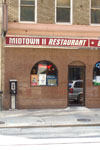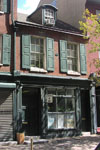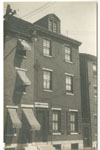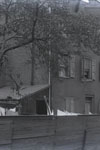Cenotaph
Epochs pass away, and things once significant---and people once important too---get neglected, and misplaced. A ‘cenotaph’ tries to remedy this with some small permanence; it is a monument honoring someone, usually notable, whose physical remains are not there.
Our darker intellects from Charles Brockden Brown to Edgar Allan Poe themselves feared, among so many other things, impermanence. And rightly so. On special occasions still, Baltimore folk honor Poe by placing roses and brandy on what has been somewhat arbitrarily designated as his grave. Poe is one of the fortunate few whose work happened to suit or fit the canon those empowered to do so after him also designated as correct, and continues to do so. Fact is his body has been alternatively neglected then moved so many times nobody is sure exactly where he lies. Might he not lose his place in the American Pantheon in a similar manner? Who can say how long as a writer he will be accepted as important and continue to serve the list of the acceptable good? These questions coalesce into the principal nightmare that plagues valid literary history.
Brockden Brown should be so lucky. Up in sometime fashionable Laurel Hill Cemetery, there is a cenotaph for Brown. But he’s not there. In putting together this show we found he has been . . . well, misplaced. None too old, the earliest accounts put Brown’s body in Friends Burial Ground at Fourth and Arch Streets. A quarter century ago, we were told by authorities there that, if his grave was ever marked, the spot “went over to other uses due to limited space”. Nothing says neglected author like having your grave paved over for a parking spot. Now Meeting officials say they are unable to find any record of Brown’s being buried there at all.
Bird and Lippard rest luckier still, the former in Laurel Hill and the latter in suburban Rockledge with a monument erected and maintained until the 1980s by the fraternal organization he created.
If we have not fully resuscitated these writers in Philadelphia Gothic, we hope we have given them a suitable wake. This exhibition is not a suitable memorial, for it is short-lived and impermanent too. It is only a small corrective to accidental cultural misplacement, or more likely displacement by what is simply popular and passes for what is currently considered important
But writers write, and literary historians too, to stave off that horror of impermanence that overtakes us all. Like the Saints said to preserve us, institutions like The Library Company and the others loaning pieces to this exhibition, treasure the import of us all, and quite literally. Here rest---as close to forever as anyone can hope---what are known in the trade as “literary remains”---not their bodies but the bodies of their work. And more. For here are their artifacts, their notes and reminders, their manuscript drafts, their sources, inspirations, mementoes, sequels, parodies, offshoots, spin-offs---all thoroughly, carefully collected and conserved, and better maintained than they were in life or in death. That is an ultimate sort of memorial.
For a literary man, or a literary historian, that seems as good as it gets. To become part and parcel of our city’s civic heritage and our American literary heritage is a very fine, a very durable thing.
In Loving Memory
Neil K. Fitzgerald
_______________________________________________________________________________________
NEXT: Coda: Gothic Fiction by American Women >



